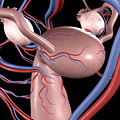(Removal of the Uterus, Abdominal Hysterectomy, Vaginal Hysterectomy)

A picture of a uterus.
A hysterectomy is a surgery that is done to remove a woman's uterus. It is used to treat conditions such as:
- abnormal bleeding
- cancers of the uterus, ovary, cervix, or endometrium (the inner lining of the uterus)
- chronic pelvic pain
- endometriosis and adenomyosis (when uterine tissue grows outside the uterus or inside the walls)
- fibroids (non-malignant tumours in the lining of the uterus)
- uterine prolapse (when the uterus enters the vagina)
Your doctor will determine if you need a hysterectomy and the type that will be performed. A total hysterectomy removes the uterus and cervix (the lower portion of the uterus that leads to the vagina). A partial hysterectomy only removes the top portion of the uterus, while a radical hysterectomy removes the uterus, cervix, a portion of the vagina, and other surrounding tissues.
A hysterectomy is performed by making an incision through the vagina or abdomen. A special camera (a laparoscope) can also be used to help guide the surgeon through the procedure. This operation is done by a surgeon at a hospital and involves using anesthesia.
Risks and precautionsIn general, surgery and the use of anesthesia come with some risks that are associated with factors like your health and what the surgery involves. Side effects are very rare but can include trouble breathing, reactions to the anesthetic, bleeding, infection, scarring, and death.
A hysterectomy is usually a straightforward and safe procedure. However, there are some risks of complications or side effects, including:
- blocked bowels
- blood clots
- damage to other organs close to the uterus (e.g., bladder, rectum, urinary tract)
- early menopause, if the ovaries are removed or if they lose their ability to function
- pain during sexual intercourse
- urinary problems
Get immediate medical assistance if you experience any of these complications or side effects.
It is important that you understand all the risks of complications and side effects of the procedure, and what you or your doctor can do to avoid them. Make sure that your doctor is aware of all your concerns.
Some people may experience complications or side effects other than those listed. Check with your doctor if you notice any symptom that worries you after your procedure.
During the testAn intravenous (IV) line may be inserted into your arm so you can be given fluids, medication, or blood directly into your body. A health care professional might also insert a catheter into your urethra (the opening where urine exits) to help empty out your bladder. An anesthesiologist will give you an anesthetic that will either numb the lower part of your body or put you to sleep entirely.
The area near the incision will be cleaned and any hair removed. The surgeon will make an incision in the lower abdomen, remove the uterus, and the incision will then be closed with stitches.
If the surgery is performed vaginally, the surgeon will make the incision inside the vagina; clamp off the blood vessels; separate the fallopian tubes, ovaries, and any other tissues; and remove the uterus through the vagina.
If a laparoscope is used, the surgeon will make several small incisions through your abdomen to insert the laparoscope and surgical tools.
The procedure takes approximately 1 to 3 hours.
Before the testIt is important that you fully understand what the procedure involves beforehand. Ask your doctor to explain the risks, benefits, and drawbacks of the procedure, and don't be shy to probe further until you are comfortable with the doctor's responses.
In preparing for a hysterectomy, you will meet with the surgeon to discuss the surgery and any questions you might have. A preadmission check will be ordered, which consists of several tests such as X-rays, ultrasounds, electrocardiograms (ECGs), or blood tests.
You may not be able to eat or drink before the procedure; it is important to follow the timing that your doctor recommends, otherwise you run the risk of the surgery being cancelled or postponed. In general, people are advised to not eat for 8 hours before the procedure and most hospitals ask that you do not drink or eat anything after midnight the night before the procedure.
If you are taking any prescription or over-the-counter (non-prescription) medications, supplements, or herbal products, make sure you inform your doctor or pharmacist. Ask them whether it is necessary for you to stop taking any of these medications and products before the procedure. It is also important to tell them if you have allergies to certain medications, bandages or latex, or have other medical conditions.
Plan to have someone drive you home from the hospital. You will also need someone to assist you with daily activities for at least a week after you leave the hospital.
After the testYou will need to stay in the hospital for a few days after the procedure. It is normal to feel these side effects after this procedure:
- pain or discomfort
- vaginal bleeding or discharge
If you were given general anesthesia before the surgery, you will be assigned to a hospital recovery room immediately after the surgery. As the anesthesia wears off, you may feel sore, groggy, thirsty, or nauseous. Nurses will be available to assist you.
After the anesthetic wears off, you will be required to stay overnight, at which point you will be moved to a regular ward for the rest of your stay. Spending one or two nights at the hospital is common for most women. Before you are released, the doctor or nurse will explain the steps you need to take to complete your recovery at home.
Your surgeon will follow-up with you to ensure that you are recovering well from the surgery. In general, the recovery period is 6 to 8 weeks for an abdominal hysterectomy, and 1 to 2 weeks for a vaginal hysterectomy.

A picture of a uterus.